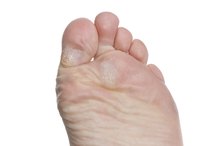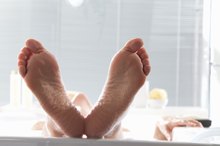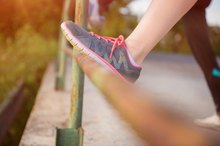Can Uncomfortable Shoes Cause Swelling?
Swollen feet can be attributed to a number of medical conditions. Often, the cause may be as simple as tight, uncomfortable shoes. Wearing properly sized shoes can help reduce discomfort. Prolonged swelling, however, may indicate a more serious problem than simply wearing high heels for too long.
Causes of Swelling
Swelling in the feet is typically caused by a buildup of fluids. Also called edema, swelling can be brought on by tight, uncomfortable shoes. Diabetes or a medical condition that causes fluid retention may also make you vulnerable to foot swelling. Understand the exact cause of swelling to determine the best footwear for your condition.
- Swelling in the feet is typically caused by a buildup of fluids.
- Also called edema, swelling can be brought on by tight, uncomfortable shoes.
Tight Shoes
Foot Calluses & Duct Tape
Learn More
Uncomfortable shoes that are tight are a common cause for swelling in the feet and legs. Tight footwear restricts blood circulation, causing a buildup in fluids in the surrounding areas. Avoid the discomfort of shoes that are too tight by wearing the correct shoe size. Don't try to "break in" shoes in a smaller size, advises the American Academy of Orthopaedic Surgeons 3. Also, choose a shoe that conforms to the shape of your foot. If your feet are wide, choose a shoe with a wide toe box.
- Uncomfortable shoes that are tight are a common cause for swelling in the feet and legs.
- If your feet are wide, choose a shoe with a wide toe box.
Other Causes of Swelling
Eating too much salt and sugar, and hormonal changes can lead to swollen legs and feet. Wearing shoes that are too tight can make the problem worse, and contribute to corns and weak ligaments and muscles. Make lifestyle changes, such as eating less processed foods and drinking more water, to help decrease swelling.
Remedies and Treatments
What Are the Treatments for Edema in Leg?
Learn More
To help stimulate circulation in your feet after wearing tight shoes, elevate your feet above your chest. Regular exercise and frequent breaks from sitting may also help relieve swelling. Diabetics and patients with edema may also benefit from compression socks. Also called compression stockings, these tight-fitting socks stimulate blood flow to the legs and feet. If you start to develop any sores or blisters in conjunction with foot swelling, contact a doctor immediately.
- To help stimulate circulation in your feet after wearing tight shoes, elevate your feet above your chest.
- Diabetics and patients with edema may also benefit from compression socks.
Related Articles
References
- Chicago Tribune: Mild leg swelling can be easily managed, but check with doctor first for accurate diagnosis
- Columbia Health: Swollen Feet
- American Academy of Orthopaedic Surgeons: Tight Shoes and Foot Problems
- Medical Daily: Pregnant Feet Swelling Causes Permanent Foot Size Increase
- Riskowski J, Dufour AB, Hannan MT. Arthritis, foot pain and shoe wear: current musculoskeletal research on feet. Curr Opin Rheumatol. 2011;23(2):148-55. doi:10.1097/BOR.0b013e3283422cf5
- Yeboah J, Bertoni A, Qureshi W, et al. Pedal Edema as an Indicator of Early Heart Failure in the Community: Prevalence and Associations With Cardiac Structure/Function and Natriuretic Peptides (MESA [Multiethnic Study of Atherosclerosis]). Circ Heart Fail. 2016;9(12):e003415. doi:10.1161/CIRCHEARTFAILURE.116.003415
- Chantelau EA. Nociception at the diabetic foot, an uncharted territory. World J Diabetes. 2015;6(3):391–402. doi:10.4239/wjd.v6.i3.391
- Sarkar M, Mahesh DM, Madabhavi I. Digital clubbing. Lung India. 2012;29(4):354–362. doi:10.4103/0970-2113.102824
- Shakoor N, Sengupta M, Foucher KC, Wimmer MA, Fogg LF, Block JA. Effects of common footwear on joint loading in osteoarthritis of the knee. Arthritis Care Res (Hoboken). 2010;62(7):917–923. doi:10.1002/acr.20165
- Medical Meanderings. American Orthopaedic Foot and Ankle Society Study. Google Books.
- Zöllner AM, Pok JM, Mcwalter EJ, Gold GE, Kuhl E. On high heels and short muscles: a multiscale model for sarcomere loss in the gastrocnemius muscle. J Theor Biol. 2015;365:301-10. doi:10.1016/j.jtbi.2014.10.036
- How to Wear High Heels to Avoid Injury. American Orthopaedic Foot & Ankle Society.
Writer Bio
Kristeen Cherney began writing healthy lifestyle and education articles in 2008. Since then, her work has appeared in various online publications, including Healthline.com, Ideallhealth.com and FindCollegeInfo.com. Cherney holds a Bachelor of Arts in communication from Florida Gulf Coast University and is currently pursuing a Master of Arts in English.







